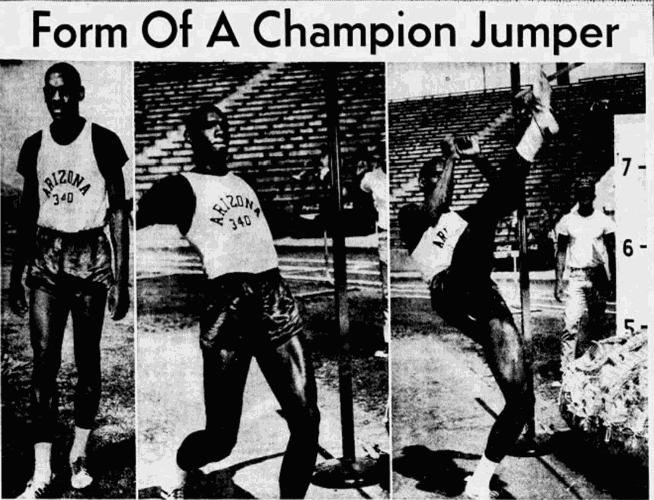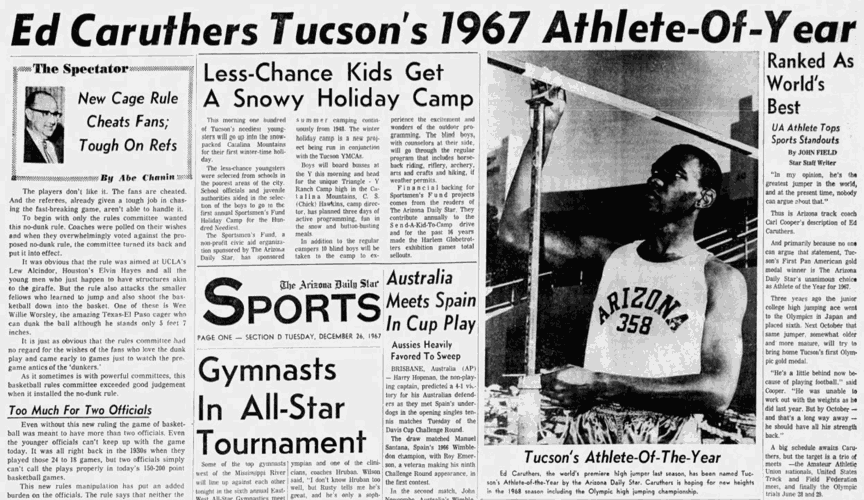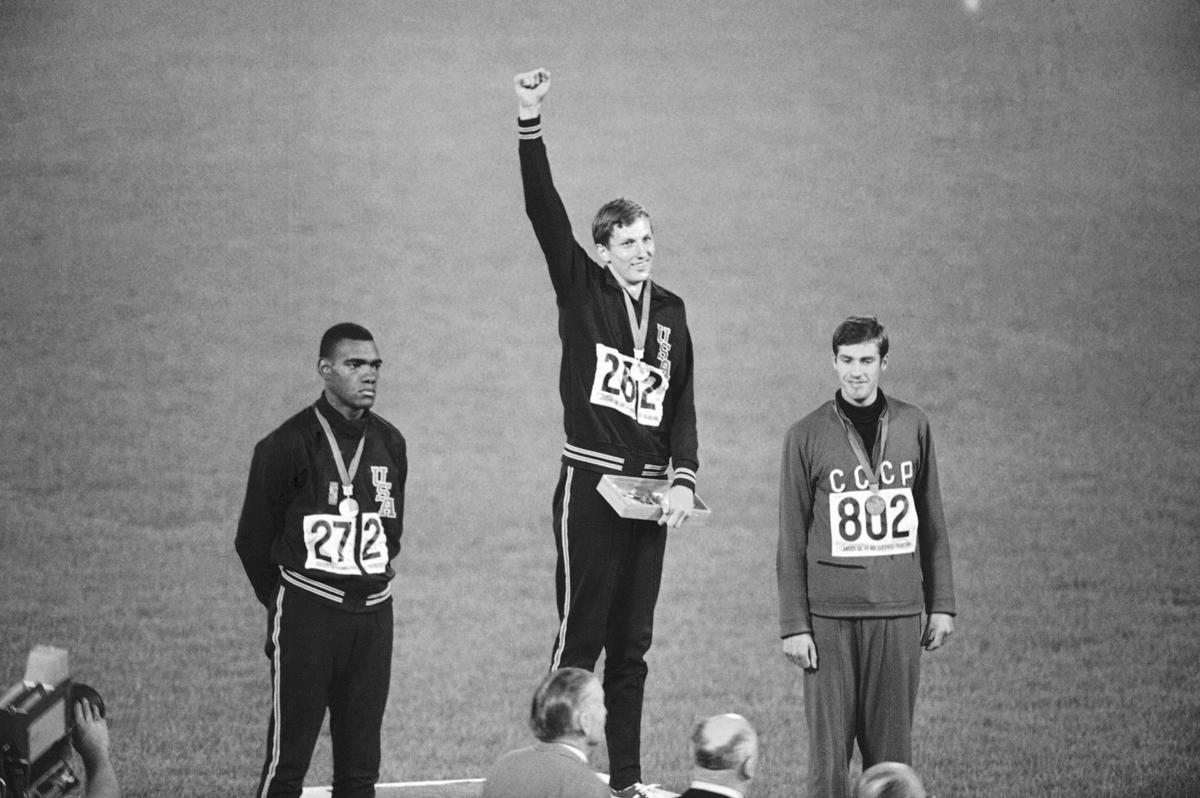Ed Caruthers is a teacher and coach whose conversational skills are such that you can almost see the punctuation — the periods, the commas and especially the exclamation marks.
“We were recently voted as the greatest track team ever!” he said a few days ago.
And there was this: “Arizona was so good for me! Moving to Tucson was a fantastic experience that shaped my life!”
On Saturday, Caruthers will celebrate the 50th anniversary of his high-jump performance at the Mexico City Olympics. He had been the world’s No. 1 ranked high jumper during most of his days on Arizona’s track team, a star among a team of Olympic stars whose roll call includes legends Bob Beamon, John Carlos, Al Oerter, Tommy Smith, Dick Fosbury and Bill Toomey.
Caruthers won the silver medal that day, Oct. 20, 1968, and now, 73, retired from a career of coaching and teaching in Orange County, California, has been able to put it in perspective.
“My connections to Tucson have been so rewarding,” he said. “It’s almost like a storybook tale.”
Caruthers grew up in a segregated area of Oklahoma City. His stepfather was a janitor, his mother a maid. They moved to Santa Ana, California, in 1958, living in an integrated community for the first time. Opportunities came his way and he took advantage of them.
At Bolsa Grande High School, Caruthers became the state champion high-jumper and an all-city football player. He was so good so quickly, a world-class athlete, that he went to the 1964 Olympic Trials before he fully knew what the Olympics were or how in the world you made the team.
But he made the 1964 Tokyo Olympics team, finishing eighth, and his life changed forever.
When Team USA traveled to Tokyo, Caruthers was assigned a room in the team barracks with Gayle Hopkins, who had just won the NCAA long-jump championship at Arizona. Theirs would become a bond that would last a lifetime.
“Gayle was a nice, friendly guy who kept saying, ‘Where are you going to go to college?’” Caruthers says now. “At the time, I was going to Arizona State. I wanted to play football as well as high-jump, and a friend of mine on the ASU football team had already hooked me up with Frank Kush. I could’ve gone to USC, but it wanted me for track only. I wanted to play football, too.”
Hopkins persisted. Arizona would be the best place for Caruthers, a place where he would be the Big Man on campus. Fellow Olympian distance runner George Young, also an Arizona All-American, added to the chorus.
Arizona track coach Carl Cooper, who would go on to be the executive director of the USA Track and Field program, took over the recruiting. Cooper pledged to get Caruthers the educational support necessary to earn a degree. He also helped his wife get a job at the UA Bookstore.
“Carl Cooper was a man of his word and a wonderful coach,” said Caruthers. “I found the right man at the right time.”

Ed Caruthers was the world’s No. 1 ranked high jumper during most of his days on Arizona’s track team.
But there was more. At Bolsa Grande High School, one of Caruthers’ teachers was Bob Smitheran, a former UA basketball player. Smitheran planted the UA seeds and watched them grow.
“Bob had returned to Tucson for his master’s degree and was in charge of one of the dorms on campus,” Caruthers remembers. “I happened to stay in his dorm. He was a good mentor; he kept asking about my career plans and I said I wanted to teach and coach. He told me, ‘When you get your degree, I’ll have a job for you at Bolsa Grande.’”
Years later, when Caruthers completed his high-jumping days — when his yearlong stint with the Detroit Lions came to an end, scuttled by injuries — it was Smitheran who welcomed Caruthers back to Orange County.
For a few years, it was complicated. Caruthers joined the UA football team in 1967, and although he wasn’t a star, his athleticism appealed to NFL teams. The Lions signed him, although he soon hurt his knee and back and ultimately was forced to leave the NFL. Caruthers later required two back surgeries.
By 1967, Caruthers was ranked No. 1 in the world. He won the Pan Am Games and a half-dozen meets in Europe. He was chosen Tucson’s 1967 “Athlete of the Year,” selected over big-league shortstop Eddie Leon and Indy 500 standout Roger McCluskey.
“Ed was as naturally gifted as any athlete I ever coached,” Cooper told me in a 1998 interview at his home near Sonoita. “He was a gold medal waiting to happen, but it never happened. It was just amazing how those ’68 Games at Mexico City turned out. Every day something earth-shaking seemed to happen. “
Two days after sprinters John Carlos and Tommy Smith performed their “black-glove” salute during the national anthem, Caruthers had a showdown with track’s newest sensation, Dick Fosbury — inventor of the “Fosbury Flop.”
Fosbury had invented the “flop”, a revolutionary back-first maneuver, a significant departure from Caruthers’ traditional style of scissoring the high bar. After a long, tense competition, after Caruthers’ 13th jump, both jumpers had cleared 7 feet 3¼ inches. Then Fosbury cleared 7-4 to win the gold medal.
Over 50 years, Caruthers has come to know the difference between gold and silver was not just ¾ of an inch, but also an act of fate. Fosbury virtually came out of nowhere to win the gold medal.
“I actually felt I was going to win the gold medal, but Fosbury was flawless,” said Caruthers. “All I could do was knock off the Russian (who won the bronze medal). I didn’t want to hear that Russian national anthem on the medal stand.”

Caruthers was 23 the day he won the silver medal in Mexico City, and he did not change his technique and adopt the Fosbury Flop. He tried the Flop in practice a few times, but it was too late. He never felt confident jumping that way, even though he was clearing 7-2 regularly.
For the next 35 years he taught and coached in the Garden Grove School District of Orange County
“Right now, Fosbury and Beamon are in Mexico City with a 50-year reunion type of thing,” Caruthers said. “There’s a reunion in Colorado Springs next week for the ’68 team, and we will be honored Dec. 2 by the USA Track and Field Association in a special ceremony in Columbus, Ohio.
“It’s rewarding that we are being remembered 50 years later. Everything worked out fantastically.”







